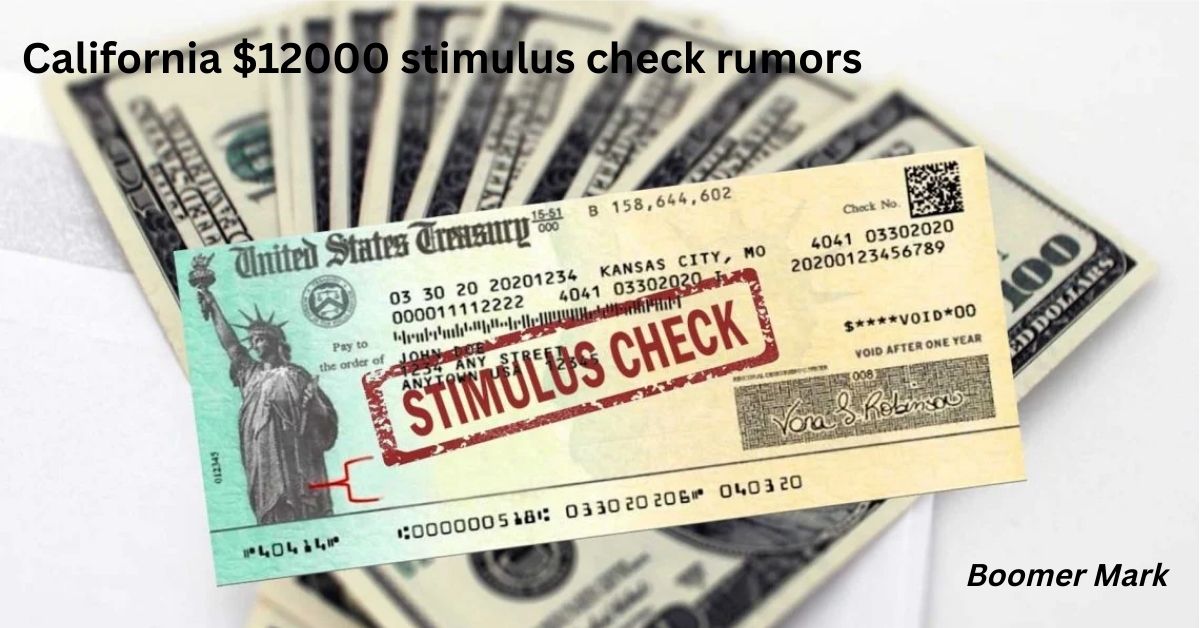Recently, rumors have been circulating about a $12,000 stimulus check being sent out to Californians. As the economic impact of COVID-19 continues to affect many, people are searching for financial relief through various stimulus programs. These rumors have sparked curiosity and confusion among individuals who are hoping for new financial assistance. However, it’s important to clarify the truth behind these rumors and understand what aid is actually available.
The Origin of the California $12000 Stimulus Check Rumors
The rumors about a $12,000 stimulus check for every Californian likely originated from social media and unverified blogs. Often, these posts are not based on official information and fail to provide credible sources. They capitalize on the widespread desire for financial relief, especially during tough economic times, and falsely claim that a large, universal stimulus check is on its way.

Social media platforms like Facebook, Twitter, and TikTok are common places where such rumors begin to spread. Once a post gains traction, it can quickly go viral, leaving many individuals wondering if the claim is real or just another misinformation trap.
What the California Government Has Officially Stated
As of now, there has been no official announcement from the California government or any federal entity about a universal $12,000 stimulus check. The California government has offered several targeted relief programs in the past, such as:
Also Read:OWP Mainframe: A Comprehensive Guide to Modern Transportation Systems
- Golden State Stimulus I and II: These programs provided payments to low- and middle-income families in California, but they were not universal and had income eligibility requirements.
- Middle Class Tax Refund (MCTR): Another round of assistance to residents was provided, ranging from $200 to $1,050 based on income and household size.
These programs were designed to target those in need, but there has been no new or confirmed $12,000 stimulus check.
Why the $12000 Amount Sounds Believable
The $12,000 figure is believable to many because it mirrors the amount that some individuals may have received in a combination of federal and state payments during the COVID-19 pandemic. These payments, including stimulus checks, unemployment benefits, and tax credits, could add up to approximately $12,000 for certain individuals or families, particularly if they were recipients of several rounds of aid.
However, this does not mean that a universal $12,000 check is being issued now or in the near future. People may be mistakenly conflating previous financial relief programs with rumors of a new payment.
Economic Relief Programs Currently Active in California
Although the rumor of a $12,000 check is not true, California does provide various forms of financial assistance. These programs continue to offer support for eligible residents:
1. CalEITC (California Earned Income Tax Credit)
The CalEITC is available to low-income working individuals and families, offering them a tax refund to help supplement their earnings. Eligibility is based on income and the number of dependents.
2. Young Child Tax Credit (YCTC)
This credit provides additional support to families with children under the age of 6. It’s available to those who qualify for the CalEITC, offering a higher payout for households with young children.
3. Middle Class Tax Refund (MCTR)
The MCTR was designed to help individuals cope with inflation and rising costs, especially gas prices. Payments range from $200 to $1,050 based on income and family size. While this program isn’t a $12,000 check, it provides essential support to many Californians.
Also Read:Coomersu: The Future of Community-Centric Commerce and Trusted Product Discovery
4. Utility Bill Assistance Programs
California residents facing difficulty with their electric and gas bills can receive help through programs like LIHEAP (Low Income Home Energy Assistance Program) and the California Arrearage Payment Program.
5. Food Assistance Programs
Programs such as CalFresh provide food assistance to low-income households. This can help families access healthy food without having to stretch their budgets further.
How to Verify Stimulus Check Information
It’s essential to verify the information you see online before acting on it, especially when it comes to financial matters. Here are some steps to ensure the legitimacy of stimulus check claims:
- Visit Official Websites: For California-related financial aid, always check the official California Franchise Tax Board (FTB) website. For federal programs, visit the IRS website.
- Check Reliable News Outlets: Trustworthy news organizations like Reuters, AP, and local news stations will provide updates on real government programs.
- Avoid Clicking on Suspicious Links: If you come across a link claiming to offer information about the $12,000 stimulus, make sure it comes from a verified and credible source.
Taking these steps can help you avoid falling victim to scams or misinformation.
Why Fake Stimulus Rumors Spread
During times of financial uncertainty, rumors about large payments can quickly gain popularity. People are looking for answers and financial relief, and scammers often capitalize on this vulnerability. These rumors often appear appealing, especially when they promise substantial amounts of money like a $12,000 check, even though they are not grounded in reality.

Furthermore, some of these false rumors may be intentionally spread for clickbait or to gather personal data from people eager for help. The spread of misinformation can cause unnecessary stress and confusion, so it’s important to stay informed and critical of unverified claims.
Also Read:Hannahoetzel2: A Deep Dive into Digital Autoethnography and Cultural Reflection
Social Media’s Role in Spreading False Rumors
Social media is one of the largest platforms for the rapid spread of rumors. Platforms like Facebook, Instagram, Twitter, and TikTok allow anyone to post news, which can then be shared quickly. When a post claiming a $12,000 stimulus check goes viral, it’s easy for individuals to assume it’s true, especially when multiple people are discussing it.
Although social media platforms have systems in place to flag misinformation, they can’t catch everything. It’s up to individuals to take responsibility for ensuring the accuracy of the information they share and consume.
How to Report Scams or False Information
If you come across a fraudulent post or scam related to stimulus checks, it’s important to report it to prevent further misinformation from spreading. Here are the steps you can take:
- On social media: Use the report function to flag misleading or harmful posts.
- To the Federal Trade Commission (FTC): ReportFraud.ftc.gov allows you to file a report if you’ve encountered a scam or fraudulent activity.
- To the California Attorney General’s Office: If you suspect a scam is targeting California residents, report it to the state’s AG office.
By reporting scams, you can help protect others from falling victim to false promises.
Impact of These Rumors on Communities
Misinformation can have a profound impact, especially on vulnerable communities. When people believe in rumors like the $12,000 stimulus check, they may stop pursuing other forms of legitimate financial aid. They may delay applying for real assistance or miss out on other resources that could help them during tough times.
Also Read:Vertėjjas: The True Bridge Between Languages and Cultures
False claims also make it easier for scammers to exploit people, especially those who are not as familiar with navigating government websites or understanding how relief programs work. This can lead to identity theft, financial loss, or unnecessary anxiety.
Realistic Expectations for Future Stimulus
Many people are hoping for another round of stimulus payments. While it’s possible that further stimulus checks could be discussed, there is no official announcement regarding a $12,000 check in California or anywhere else. Any future payments would need to be approved by both the state and federal government, and it’s unclear what form they would take.
To stay up-to-date, it’s essential to follow trustworthy news sources and government websites, as these will provide accurate information about any future relief programs.
How to Protect Yourself Online
To avoid falling victim to scams related to stimulus check rumors, follow these tips:

- Never share your Social Security number, bank details, or personal information with unknown parties.
- Avoid clicking on suspicious links or downloading files from unverified sources.
- Set up two-factor authentication for your online accounts.
- Use trusted websites to check for the latest information about government programs.
Staying vigilant online can help protect your personal data from fraudsters.
People Most Affected by These Rumors
Certain groups, such as low-income individuals, elderly people, and non-English speakers, are more susceptible to misinformation. They may have limited access to reliable news sources or may be more trusting of rumors spread through their social circles.
Community organizations, local leaders, and social service agencies can play a key role in countering these rumors and guiding people to accurate, trustworthy information.
Media Responsibility in Handling Rumors
News organizations and influencers have a responsibility to verify the information they share. Publishing misleading or false stories, especially about something as important as financial relief, can cause unnecessary panic and confusion. Responsible journalism involves checking facts, referencing official sources, and clearly indicating when information is speculative or unverified.
Also Read:Bıql: What It Is, Why It Matters, and How You Can Use It Today
What to Do if You Need Financial Help Now
If you are facing financial challenges and hoped for a $12,000 stimulus check, there are still many real programs available to you. California offers programs like:
- CalEITC for low-income workers.
- MCTR for middle-class families.
- Utility assistance for those struggling with their electric and gas bills.
- Food programs like CalFresh.
Start by contacting your local resources or visiting government websites for assistance.
Expert Advice on Financial Relief
Financial experts recommend budgeting, looking for ways to cut unnecessary costs, and taking advantage of available programs. While rumors like the $12,000 check may be tempting, focusing on verified aid and sound financial practices will help you in the long run.
How to Help Others Avoid Scams
If you come across a rumor about the California $12000 stimulus check, share accurate information with friends and family. Help them avoid falling for scams by explaining why the rumor is false and directing them to reliable sources of information.
Frequently Asked Questions (FAQs) about California $12000 Stimulus Check Rumors
Is there really a $12,000 stimulus check in California?
No, there is no official announcement of a $12,000 stimulus check in California. The state has offered targeted relief through other programs, but there is no universal check.
When will California offer more stimulus checks?
While future stimulus checks are not guaranteed, it’s best to stay updated by checking official sources like the California Franchise Tax Board and the IRS.
How can I avoid falling for stimulus check scams?
Verify all information through official government websites and avoid clicking on suspicious links or sharing personal information with unknown parties.
What relief programs are currently available in California?
California offers several financial assistance programs, including the CalEITC, Middle Class Tax Refund, and food and utility assistance programs.
Can I still apply for California’s financial assistance programs?
Yes, you can still apply for California’s financial assistance programs, such as CalEITC, MCTR, and food or utility aid. Be sure to check the eligibility requirements and deadlines on the official California government websites to ensure you qualify for the assistance.
Conclusion(California $12000 Stimulus Check Rumors)
The rumors of a $12,000 stimulus check in California are not true, and it’s important to stay informed by checking reliable sources. While the state does offer financial assistance, it is typically targeted to specific groups, not universally available to all residents. By being cautious and avoiding misinformation, you can better navigate the available relief programs and get the help you need.
